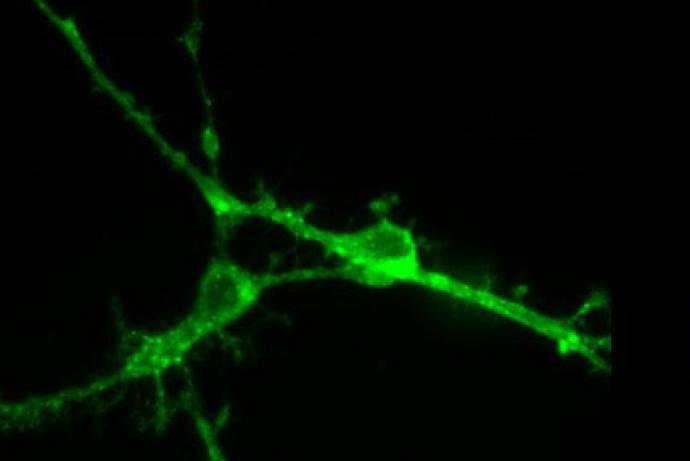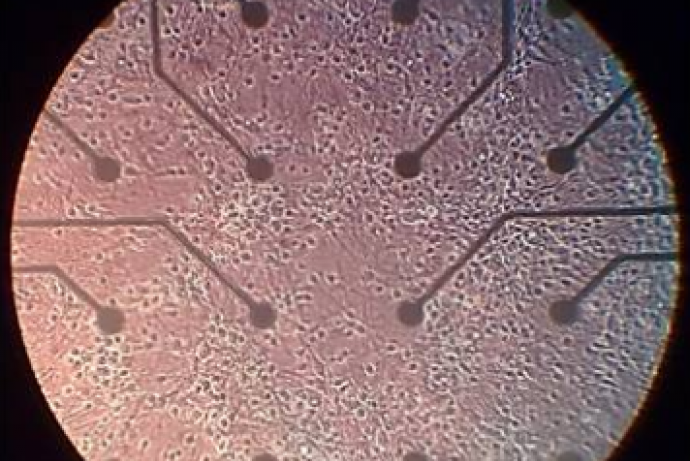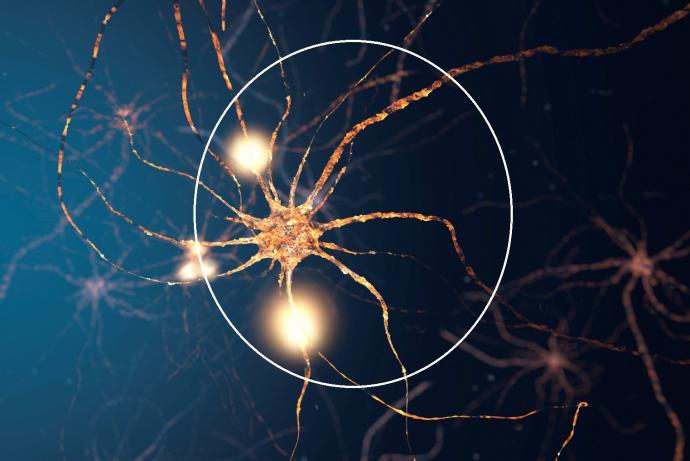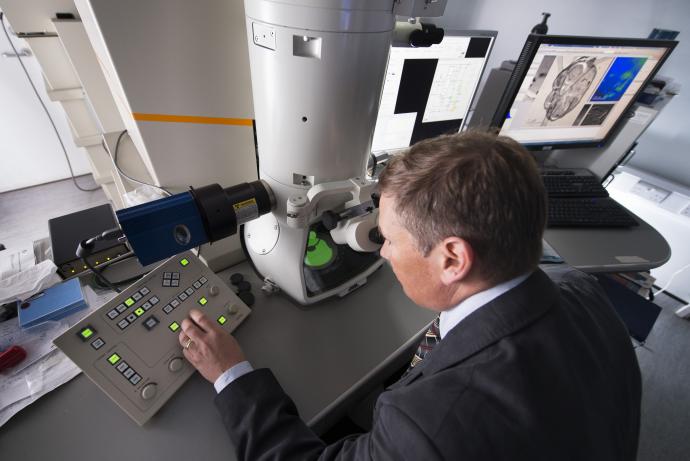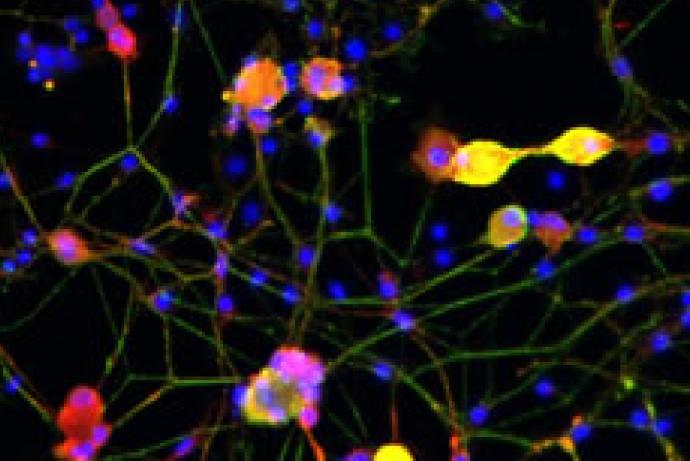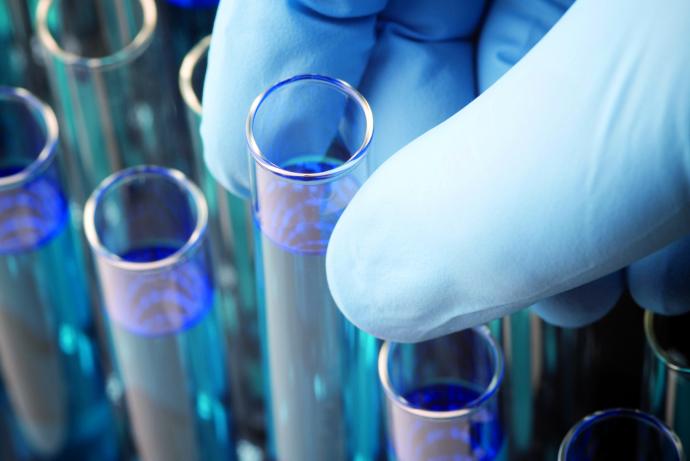The BLB-Test is a portable, automated assay for detecting BoNT as a replacement for the mouse lethality bioassay (MLB). The BLB-Test is integrated into a microfluidic platform that contains all the reagents for the assay, and programmed operation of the BLB-Test is done from a laptop. The assay can distinguish and quantify all the known disease causing BoNT serotypes in buffer and complex media. Partnerships are sought with end-users interested in helping to validate the BLB-Test on a broad range of complex matrices that could be contaminated with BoNT or companies interested in producing and commercializing the BLB-Test.
Through CRACK IT Solutions Dr Stevens is currently working with multiple European partners on a Solutions funded project to validate the BLD-Test so that it may be successfully adapted and developed to replace the mouse bioassay.
This project and its impacts are featured as a case study in the 2019 CRACK IT Review.
Botulism is a potentially fatal paralysis caused by BoNT which blocks neurotransmitter release. With an estimated LD50 of 1 ng/kg body weight, the family of eight BoNT serotypes, subdivided into a total of more than 40 subtypes, are the most toxic naturally occurring substances known.
The most widely accepted method for BoNT detection is the MLB (Dorner MB et al., 2013). This has a sensitivity, depending upon the BoNT type, of 10-100 pg/mL (Dorner MB et al., 2013). In this assay, mice are injected intraperitoneally with a solution that is suspected to contain BoNT. Observation of symptoms such as laboured breathing, weakness of limbs, and finally death are required to confirm the presence of BoNT. The MLB requires a long readout time of 1-4 days; uses a large number of mice (> 100) for serotyping and precise quantitation; and the toxicity depends on the age and strain of mice used, leading to variability in sensitivity (Dorner MB et al., 2013). To overcome these limitations, in vitro BoNT assays have been developed. The most commonly used of these are ELISA-based.
Although some laboratory-based immunoassays are highly sensitive and specific, they require a large panel of specific high-affinity antibodies to reliably detect the increasing number of known subtypes, currently more than 40, and might miss novel serotypes, thereby producing false negative results (Dorner MB et al., 2013). No single immunoassay has been produced to detect all BoNT subtypes. Although some immunoassays are highly sensitive with readout times of 4-6 hours, they are unlikely to discriminate active from inactive BoNT (Dorner MB et al., 2013).
Other in vitro BoNT assays include the endopeptidase assays and cell-based assays, both of which can detect BoNT with sensitivities exceeding the MLB. However, these assays are laboratory based and require highly trained personnel to provide reliable results due to the need for highly sophisticated equipment and techniques (Dorner MB et al., 2013; Pellett S 2013).
References
- Dorner MB, Schulz KM, Kull S, et al. (2013). Complexity of botulinum neurotoxins: challenges for detection technology. Curr Top Microbiol Immunol 364: 219-55. doi:10.1007/978-3-642-33570-9_11
- Pellett S (2013). Progress in cell based assays for botulinum neurotoxin detection.Curr Top Microbiol Immunol 364: 257-85. doi: 10.1007/978-3-642-33570-9_12
The BLB-Test (Stevens GB et al., 2013), consists of immobilized polypeptides that tether a reporter molecule. The polypeptides are cleaved by BoNT, releasing the reporter molecules which are detected by an optical readout. The assay detects the endopeptidase activity of the light chain domain of BoNT, thereby detecting only active BoNT and avoiding potential false positives caused by inactive BoNT. The BLB-Test can detect and distinguish all the disease-causing BoNT serotypes: A, B, C, D, E and F, as well as mixed types H/F5, A/B, A/F, B/F, B/H, and the closely related tetanus neurotoxin (TeNT).
The polypeptides used in the BLB-Test are based on the naturally occurring substrates of BoNT that form the SNARE complex of neurons. Different BoNT serotypes have specific cleaveage sites on the SNARE complex, and so modifications in the amino acid sequences of these polypeptides allow the various serotypes to be distinguished. Cross reactivity with untargeted serotypes is negligible, thereby providing highly specific detection required for targeted therapy of botulism patients.
BoNT detection with the BLB-Test is automated and can be performed with minimal training/expertise: liquid samples or extractions from solids are dispensed into a microfluidic disk which is then loaded into the disk reader (van Oordt T et al., 2013). During operation, a metered amount of sample is distributed to each reaction chamber where it is analysed after an incubation period depending on the required sensitivity. After analysis the single use disk containing the specimens can be safely destroyed. The sensitivity of the BLB-Test in various matrices is still being assessed for all the known disease causing serotypes. However, the limit of detection to BoNT/A is 40 fM (6 pg/mL) (Stevens GB et al., 2013), which is comparable to the sensitivity of the MLB (Dorner MB et al., 2013).
The high sensitivity and ability to detect and distinguish the disease-causing BoNT serotypes should make the BLB-Test useful for analysis of samples from human and animal, foodstuff and environmental samples. The BLB-Test can detect BoNT in complex matrices without the need for sample pre-treatment. Matrices successfully tested so far include blood plasma, milk, bouillon and carrot juice. It could therefore be applied to a wide range of security, food safety and health care services.
References
- Dorner MB, Schulz KM, Kull S, et al. (2013). Complexity of botulinum neurotoxins: challenges for detection technology. Curr Top Microbiol Immunol 364: 219-55. doi:10.1007/978-3-642-33570-9_11
- Stevens GB, Silver DA, Zgaga-Griesz A, et al. (2013). Bioluminescence assay for the highly sensitive detection of botulinum neurotoxin A activity. Analyst 138(20): 6154-62. doi: 10.1039/c3an00525a
- van Oordt T, Stevens GB, Vashist SK, et al. (2013). Rapid and highly sensitive luciferase reporter assay for the automated detection of botulinum toxin in the centrifugal microfluidic LabDisk platform. RSC Advances 3(44): 22046-22052. doi: 10.1039/C3RA44482A
Partnerships are sought with end-users who are interested in helping to thoroughly validate the BLB-Test on a broad range of complex matrices that could be contaminated with BoNT. These include patient specimens, environmental samples, food and beverages, animal feed, gardening products etc. Collaborators would ideally have expertise in testing for BoNT in veterinary or farm settings, hospital laboratories, pharmaceutical companies, government testing labs, or with military or emergency services.
The researchers hope to form partnerships with companies interested in producing and commercializing the BLB-Test, particularly those with experience in production, distribution and marketing ´point of need´ diagnostics or biological assays.
Finally, institutional collaborators are sought with expertise in the biochemistry of cellular membranes and receptors, and who are interested in joining the team to apply for research grants. The researchers propose to extend the BLB-Test to detect BoNT binding to membrane receptors, and translocation of the proteolytic light chain domain of BoNT through pores formed in endosome membranes.
The MLB is used extensively for testing products and samples that are suspected to contain BoNT. According to German standard DIN 10102 and AOAC official method 977.26 (Dorner MB et al. 2013), in vivo testing strategies require up to 20 mice per BoNT containing sample (i.e. >140 animals to fully serotype each specimen). It was estimated that approximately 600,000 mice were used worldwide in 2009 for diagnostics and pharmaceutical purposes (Bitz S 2010). The test method causes severe distress to the animals, due to death by slow asphyxiation over a period of up to 4 days.
In its present form, the BLB-Test can be used to replace the MLB in most circumstances because it can detect, distinguish and quantify all the serotypes (BoNT A-F) that are known to cause disease in humans and animals. BoNT/G, which is not linked with disease (Dorner MB et al., 2013), cannot currently be detected with the BLB-Test at the concentrations presently available. However, since BoNT-G cleaves the same substrate polypeptide as BoNT-B, it should in principle also be detectable at millimolar concentrations. In summary, with the ability to distinguish the main BoNT serotypes in complex matrices the BLB-Test has the potential to dramatically reduce the number of mice used in testing and serotyping BoNT specimens.
References
- Bitz S (2010). The Botulinum Neurotoxin LD50 Test - Problems and Solutions. Altex-Alternatives to Animal Experimentation. 27(2): 114-116.
- Dorner MB, Schulz KM, Kull S, et al. (2013). Complexity of botulinum neurotoxins: challenges for detection technology. Curr Top Microbiol Immunol 364: 219-55. doi:10.1007/978-3-642-33570-9_11
Overview | Impacts | Publications
Overview
Through CRACK IT Solutions Dr Stevens is currently working with multiple European partners ranging from academics, small companies and government organisations on a project to validate the BLD-Test so that it may be successfully adapted and developed to replace the mouse bioassay. This CRACK IT Solutions funded study will characterise, validate and document the performance of the bioassay so that users and regulators can have a high level of confidence in the ability of the BLD-Test to distinguish and detect different concentrations of BoNT in complex biological matrices.
Impacts
Working with eight partners, including four from Germany – toxogen, QIAGEN Lake Constance, the research institute Hahn-Schickard and public health Robert Koch Institute – as well as the UK National Institute for Biological Standards and Control, Greg characterised and validated the performance of the BLD-Test. In an international ring trial of the BLD-Test, five participating laboratories could identify BoNT-containing samples (without serotyping) in different concentrations in serum, bean juice and carrot juice in only three hours compared to up to 24 hours for the mouse bioassay.
Around 600,000 mice are used annually for screening and serotyping BoNT specimens, and for assessing the safety of botulinum products for therapeutic purposes. Applying the BLD-Test could substantially reduce the number of mice used for diagnostics. Based on the findings of the ring trial Greg, Hahn-Schickard and toxogen continue to collaborate to further improve the sensitivity, specificity and stability of the BLD-Test, with the aim of marketing it as an alternative to the mouse bioassay. The BLD-Test is protected by European and US patents.
Publications
Weisemann J et al. (2016). A functional assay devoid of antibodies for serotyping and detection of botulinum neurotoxins. Toxicon 123:S84. doi: 10.1016/j.toxicon.2016.11.231
Stevens GB, Zgaga-Griesz A, Silver DA, Krueger M, Urban GA 2017, Assay for Clostridium botulinum neurotoxin, EP 2 764 115 B1
Stevens GB, Zgaga-Griesz A, Silver DA, Krueger M, Urban GA 2018, Assay for Clostridium botulinum neurotoxin, USPN 10,131,933
